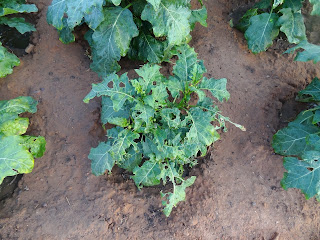Recently, I spent some time visiting various forest garden
sites in Senegal with Curtis McCoy, Program Manager for Trees for the
Future. It was an opportunity for me to
visit with Senegalese participant farmers from different regions of the
country. Many of these forest gardens
are a bit more mature, as they have been working with Trees for the Future for
a number of years already.
 |
| A typical forest garden in its first year. |
Each site is unique, yet they all conform to an agroforestry
model. That is, trees are planted in the
same area as the vegetable crops. This
benefits the farmer in several ways.
First, the trees reliably provide fruit (mangoes, soursoup, desert
apple, oranges, lime, papaya, and banana) under low maintenance
conditions. Second, trees greatly
improve soil fertility and structure as they recycle nutrients from deeper soil
depths. Lastly, the trees provide
shelter for the more delicate vegetables.
It gets hot here in Africa (115 degrees F during April and May), and
often the wind blows in from the Sahara desert to the north. Dappled shade is extremely welcoming in
gardens growing tender lettuce and tomatoes.
Farmers have generally embraced the techniques promoted by
Trees for the Future, though it will take some time and repetition to get most
farmers to see the efficacy of certain permaculture techniques. In many gardens, the soil is really poor and
compacted. Getting vegetables to grow and to produce something is the first
step. Step two is to maximize
production.
 |
| Training session with the lead technicians with Trees for the Future. |
In addition, those who choose to grow vegetables during the
peak of hot season (March through June) have another difficulty to overcome:
insects! It is not only the animals who
go on their annual weight loss plan, the insects do as well. When you create an oasis of green in the
vastness of leafless trees and dead weeds, you are inviting trouble for
yourself. Dry season gardening creates
challenges that I am still trying to find effective solutions for. It is disheartening to spend weeks growing
and watering cabbages, only to see them get eaten alive by caterpillars. In other cases, the plants will still produce
fruit, but not as prolifically as when the insect pressure is negligible.
 |
| An example of insect damage to the African vegetable Jaxatu. |
Human nature invites us to take shortcuts, no matter what
country you live in. However, as I have
said before, the earth knows what it needs, and the more completely you
understand this dictate, the more prosperous you will become. I am not under the illusion that every
participant will create a textbook model forest garden. The adjustment process will vary from
participant to participant, but eventually, those with a sincere interest and
passion for agriculture will get it. And
what they worked so hard to achieve, they will fiercely protect from destruction.
Fiercely protecting the environment.
Now that is something that will save Africa!

I enjoy reading about your journey, Dan. Keep up the good work in Africa!
ReplyDelete